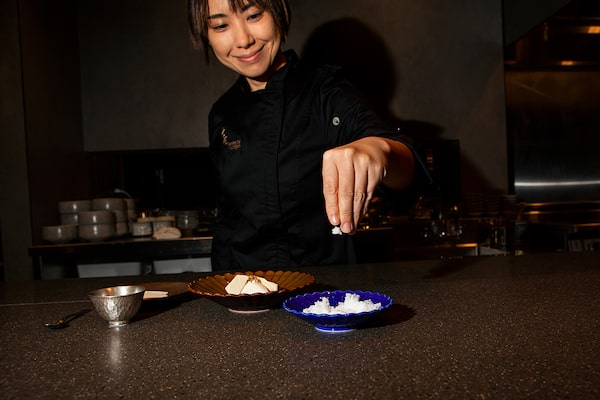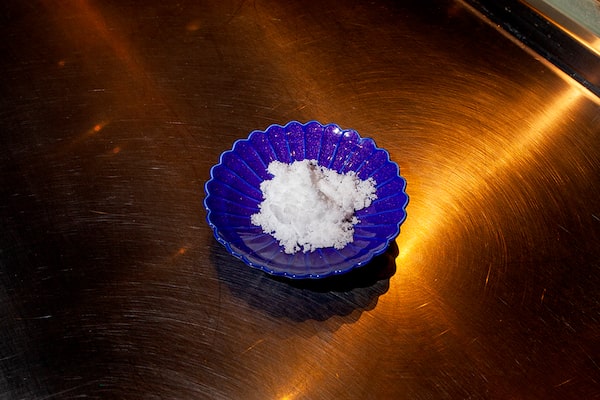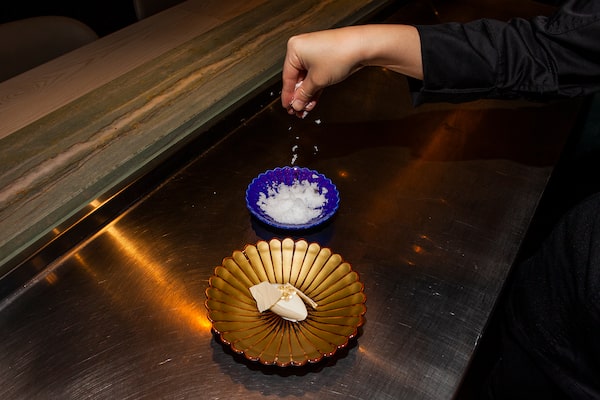
Aiko Uchigoshi, executive pastry chef at Toronto’s Aburi Hana, prepares the young ginger honey ice cream Wasanbon (Japanese cane sugar) meringue dish, with honey pearls for garnish.Sarah Palmer
Where’s the salt? It’s the most common question asked of contestants on competitive-cooking reality shows.
Salt is critical because it helps enhance certain flavours. Without it, “the umami, sweetness and flavour will be diminished,” says Aiko Uchigoshi, executive pastry chef at Toronto’s Aburi Hana, one of the first restaurants in Canada to receive a Michelin star. Jae-Anthony Dougan agrees. “[Salt is] one of the top ingredients because it touches a part of the tongue that is like a pleasure centre,” says the executive chef and co-owner of Tropikal, an upscale Caribbean restaurant with locations in Montreal and Ottawa.
More or less?
If the world’s most popular seasoning is so important, why do those reality-show contestants typically fail to put enough in their dishes? “[Home cooks] have a hard time convincing themselves to put [in] enough salt,” says Joël Watanabe, executive chef and owner of Kissa Tanto, a Michelin-star Italian-Japanese fusion eatery in Vancouver. “I think it’s because they’re afraid to keep going.”
They might also hold back an extra shake or two because of salt’s reputation.
Regularly consuming more than the recommended amount of sodium can lead to high blood pressure, according to Health Canada, which also points out “most people in Canada eat too much sodium.” It adds that “limiting highly processed foods” is the primary way to reduce intake.

Seto Honjio sea salt used by chef Aiko Uchigoshi, described as a mildly flavoured rough salt containing bittern, made from the seawater of Setouchi and Bizen Okayama. It's a moist salt with 'bitter' ingredients from the sea. It has a moderate saltiness and a mellow taste, and chef Uchigoshi says it brings out the flavour of dishes and their ingredients.Sarah Palmer
To salt or not to salt
Knowing when to add salt (and when not to) takes a bit of research or – in the case of these three chefs – experience. “A lot of people make steak wrong and they add salt before they grill it,” Dougan says as an example. “It should only be added at the end because it dries out your steak and releases the juices.” Some dishes, he points out, don’t require it at all: “I like to cook with a lot of seafood and fish. Especially lobster and certain crustaceans, salt is not needed. Just a nice butter or compound butter or something is perfectly fine.”
Watanabe says dishes with seaweed sometimes don’t need it either as it’s already “salty enough.”
What does require salt?
Many desserts actually – to help balance out the sweetness. Uchigoshi adds some to Aburi Hana’s young ginger honey ice cream and Sakura leaves creme brûlée, and Dougan puts it in Tropikal’s plantain doughnuts, cheesecake and plantain banana split. Don’t forget to salt your pasta water, Watanabe says. “When I was trained [we were told to] season it like it tastes like the ocean,” he says. “I can go to a restaurant and I’ll know if they cook their pasta in water that wasn’t salted enough … I can sense the difference. … You lose a little bit of harmony between the pasta and the sauce itself.”
Google searches and recipes are places for home cooks to start their own journeys, and there are plenty of salt-specific cookbooks and guides, too. Like Naomi Duguid’s The Miracle of Salt, Samin Nosrat’s Salt Acid Fat Heat or Mark Kurlansky’s Salt: A World History, which is on Watanabe’s reading list.

Young ginger honey ice cream Wasanbon (Japanese cane sugar) meringue dish from Toronto's Aburi Hana restaurant.Sarah Palmer
Home chefs, take note
There are plenty of unique and fancy salts the fine-dining chefs like to use from time to time. Uchigoshi loves fleur de sel for its “mellow sweetness,” and Watanabe has fond memories of cooking in Montreal with French grey sea salt. All three chefs say staples such as natural pink Himalayan, kosher and Maldon are the best varieties for home cooks.
For those taking notes: Himalayan is ideal for sauces, marinades or adding to your food at the dinner table, kosher is best for seasoning meat and vegetables, and Maldon or good-quality salt flakes are good for garnishing.
Most recipes say “season to taste” for a reason. “Because everybody is kind of different on how they perceive seasoning,” Watanabe says. “Layer your seasoning throughout the cooking process” by sampling your dish as you cook, so you get an idea of what it needs.
If there’s one thing to take away from these professional chefs, it’s this gem from Dougan: “[They say] you’re supposed to taste your dish at least 20 times before you even plate it.”
One in a regular series of stories. To read more, visit our Inspired Dining section.
Editor’s note: A previous version of this article included incorrect information about the composition of salt. This version has been updated to remove the incorrect information.